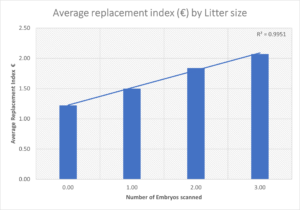Five-star ewes across a range of maternal traits are proving to achieve greater reproductive performances on sheep farms, according to Sheep Ireland.
When a ewe is being genetically evaluated for her maternal traits, the number of lambs produced reflects her prolificacy and this is reflected in her number of lambs born (NLB) sub Index.
NLB is reflected in her overall replacement index and accounts for 19% of the replacement index.
Aisling O’Mahony of Sheep Ireland has said this trait is “very important to farmers when selecting their replacement ewes for breeding”.
Five and one-star replacement ewes
O’Mahony described the impact of choosing five-star replacement ewes has had on the flock of Peadar Kearney in Co. Louth.
Kearney is a commercial sheep farmer based in Dundalk, who has been farming the same land as many generations before him, and for the past 22 years on his own.
His flock consists of mainly Bluefaced Leicester, Texel and Suffolk cross ewes, with 215 breeding ewes due to lamb down this spring.

Kearney scanned his ewes in December 2023, and the results of this scan show that his five-star replacement ewes are producing more lambs than his one-star ewes.
The below graph is comparing the results of 215 ewes scanned.

On average, his five-star ewes are producing 0.46 more lambs than their one-star counterparts, equaling to nearly half a lamb more on the ground.
His average five-star ewe is producing 0.26 more lambs than his flock average (another 25 lambs per 100 ewes).
Kearney said: “In previous years, I chose my replacement ewes based on growth rate.
“Looking at this year’s scanning results and the massive difference between the one-stars versus four or five-stars, it’ll be a deciding factor going forward for keeping ewes”.
In the graph below, the average ewe replacement index for barren, singles, twins and triplets in Kearney’s flock can be seen.
O’Mahony said: “This measurement has greater accuracy than the replacement stars alone, as this figure compares across breeds.”

In the above graph, O’Mahony explained the replacement index is highly correlated with the number of embryos scanned.
Correlation refers to the relationship between two variable traits, in this case the average number of lambs scanned and the average replacement index of each ewe.
Sheep Ireland has stated that ewes with higher economic breeding values (EBV) in the replacement index are proving to be making more profit at farm level.
The organisation added that commercial farmers “will benefit in profit by choosing a high replacement indexed ram”, and that they “should consider seeking rams with high EBV’s when selecting rams for purchase”.
Keeping their breeding policy in mind, if farmers wish to breed both replacement ewe lambs and lambs for slaughter, then a high replacement index ram should be purchased.
The € value of the replacement index is across breed, comparing every breed of ram to each other and represents the difference in profit produced by each lamb sired by that ram.
The replacement index € value is displayed on sale catalogues and on Ram Search in the €uro-Stars section.
The Euro-Star Indexes are designed to aid sheep farmers in the selection of more profitable breeding animals, O’Mahony added.
